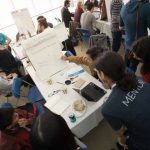MIT Shows How To Run Hackathons
 I’ve always had mixed feelings towards hackathons, as whilst they undoubtedly bring a lot of focused energy, they often lack any real follow-up, rendering the progress made during the weekend rather isolated.
I’ve always had mixed feelings towards hackathons, as whilst they undoubtedly bring a lot of focused energy, they often lack any real follow-up, rendering the progress made during the weekend rather isolated.
A recent paper in Cell Systems highlights how the MIT Hacking Medicine events do better. The events, which are open to all, but are especially popular with younger engineers, researchers, doctors and entrepreneurs, identify key healthcare issues to solve.
The events have spawned at least 15 different companies, with those ventures raising over $100 million in venture funding. It’s a track record that really marks the event out from its peers.
“The short- and medium-term gains in healthcare are not going to be from one-off Thomas Edisons doing their own thing to invent the light bulb,” the authors say. “Everything is so multi-disciplinary now that you need to know where you run short of expertise and complement your skill sets through collaboration.”
A four staged approach
The MIT hackathons go through a four-phase approach:
- Identification of the problem
- Description of the challenge
- Alteration via the innovation
- Implementation of the change
The events have helped to produce a wide range of fascinating startups, including PillPack (prescription adherence), CAKE (end-of-life care), Augmented Infant Resuscitator (improved bag-valve-mask for neonates), Perfect Latch (breast pump design), Arsenal Health (patient scheduling), and Podimetrics (diabetic foot ulcers).
The authors believe that the hackathons are so successful due in large part to the social and academic values of the events, with large groups of like minded individuals gathered together and helped to innovate.
“Our goal isn’t for our event to launch companies, it’s to teach people to incorporate design thinking and user feedback–or how to conduct an interview so that you know what you’re designing is hitting the right levers,” they say. “We see ourselves as an education program that all the MIT Hacking Medicine community members have put a lot of love into.”
So successful have they been that they have been recruited by various health technology groups to help them design incubators and accelerators of their own. As part of this, the team have developed a free handbook (pdf) for groups wishing to run an event of their own. The handbook contains a useful guide, with best practice tips from the many events run by the group.
“Research is all about being out there and being totally new, and that’s great, but at the same time, we have such a wealth of problems to solve today, right now,” they say. “We are showing scientists and physicians that no matter what they are working on, they can be an entrepreneur and incorporate the design process without getting an MBA or being a consultant in a previous life. People come to our events and feel like they can do this.”
Wait! Before you go…
Choose how you want the latest innovation content delivered to you:
- Daily — RSS Feed — Email — Twitter — Facebook — Linkedin Today
- Weekly — Email Newsletter — Free Magazine — Linkedin Group
 Adi Gaskell tells us: “I am a free range human who believes that the future already exists if we know where to look. From the bustling Knowledge Quarter in London, it is my mission in life to hunt down those things and bring them to a wider audience, with my posts here focusing particularly on the latest research on innovation and change.” Follow Adi @adigaskell
Adi Gaskell tells us: “I am a free range human who believes that the future already exists if we know where to look. From the bustling Knowledge Quarter in London, it is my mission in life to hunt down those things and bring them to a wider audience, with my posts here focusing particularly on the latest research on innovation and change.” Follow Adi @adigaskell
NEVER MISS ANOTHER NEWSLETTER!
LATEST BLOGS
Four ways you can ensure employees take accountability for their work
One of the most important driving factors for any successful business is a high-performing team. Having people working for you…
Read MoreWhat is digital upskilling and why is it important?
Photo by Annie Spratt on Unsplash In a world of business that never stands…
Read More


